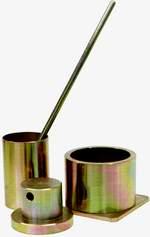AGGREGATE CRUSHING VALUE
This test helps to determine the aggregate crushing value of coarse aggregates as per IS: 2386 (Part IV) – 1963. The apparatus used is Cylindrical measure and plunger, Compression testing machine, IS Sieves of sizes – 12.5mm, 10mm and 2.36mm
Procedure to determine Aggregate Crushing Value
i) The aggregates passing through 12.5mm and retained on 10mm IS Sieve are oven-dried at a temperature of 100 to 110oC for 3 to 4hrs.
ii) The cylinder of the apparatus is filled in 3 layers, each layer tamped with 25 strokes of a tamping rod.
iii) The weight of aggregates is measured (Weight ‘A’).
iv) The surface of the aggregates is then leveled and the plunger inserted. The apparatus is then placed in the compression testing machine and loaded at a uniform rate so as to achieve 40t load in 10 minutes. After this, the load is released.
v) The sample is then sieved through a 2.36mm IS Sieve and the fraction passing through the sieve is weighed (Weight ‘B’).
vi) Two tests should be conducted.
Aggregate crushing value = (B/A) x 100%.

If you have a query, you can ask a question here.



what will be the lower and higher values of acv
and what is the permissible values
Aggregate crushing value, when
determined in accordance with IS: 2386 (Part IV)-1963 shall not exceed
45 % for aggregate used for concrete other than for wearing surfaces,
and 30 percent for concrete for wearing surfaces, such as runways, roads
what should be done if the acv value is below 30%
it is the deciding factor whether it should be used in sub layer or upper layer according to standard value it should be less than 30%
If it is coming below 30% then you can use those aggregates for construction work (for runways,highways and building construction).
as per is code it should not be more than 25% for wearing surfaces & 45% for non wearing surfaces.
what is the standard aggregate (crushing, impact and abrasion) values of sharp sand in accordance with British Standard. Tanx
Kindly explain what absortion of aggregate is?dis is helpful
I so much luv engineering
What is electr drainage and electro injection? According to soil mechanics
know of any formula allowing to estimate dry TFV from ACV value?
Pls, can i get the ACV range of Granite, Basalt, Limestone, felspar
D site is really rich in knowlege
What about other fractions of the aggregate sample, i.e larger than 12.5 mm and less than 10 mm?
It is true that you are creating the world
Pls reply me, what will we conclude when ACV get 24%???
please how can i determine ACV for 20mm and 10mm coarse aggregate
according to IS 2386 (Part iv)-1963 aggregate crushing value is designed for only for IS Sieves of sizes – 12.5mm, 10mm and 2.36mm, for 20mm and 10mm coarse aggregate we need to take different ranges of sieves, then cylinders size will also changes….
why the aggregate retained in 10mm sieve can be taken for test?
Aggregate sizes greater than 12.5mm will also be retained in 10mm. So we need which is less than 12.5mm(passing through) and greater than 10mm(retained)
Plz Explain sir why impact 25times only
what is meant by filling cylinder in 3 layer?
can this test (ACV) be conducted on granitic aggregates??
I want to know the relationship between ACVand compressive strength
Not only thank-you Real thank-you….
what is the limit of agg. cruising value